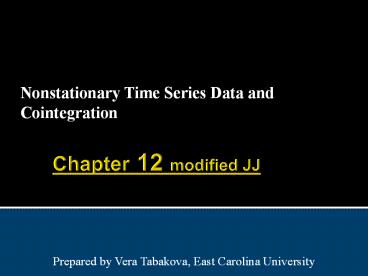Chapter 12 modified JJ - PowerPoint PPT Presentation
1 / 42
Title:
Chapter 12 modified JJ
Description:
... 12.4 Cointegration 12.4 Cointegration 12.4.1 An Example of a Cointegration Test 12.4.1 An Example of a Cointegration Test 12.5 Regression When There Is ... – PowerPoint PPT presentation
Number of Views:79
Avg rating:3.0/5.0
Title: Chapter 12 modified JJ
1
Chapter 12 modified JJ
- Nonstationary Time Series Data and Cointegration
Prepared by Vera Tabakova, East Carolina
University
2
Chapter 12 Nonstationary Time Series Data and
Cointegration
- 12.1 Stationary and Nonstationary Variables
- 12.2 Spurious Regressions
- 12.3 Unit Root Tests for Stationarity
- 12.4 Cointegration
- 12.5 Regression When There is No Cointegration
3
12.1 Stationary and Nonstationary Variables
- Figure 12.1(a) US economic time series
4
12.1 Stationary and Nonstationary Variables
- Figure 12.1(b) US economic time series
5
12.1 Stationary and Nonstationary Variables
(12.1a)
(12.1b)
(12.1c)
6
12.1 Stationary and Nonstationary Variables
7
12.1.1 The First-Order Autoregressive Model
(12.2a)
8
12.1.1 The First-Order Autoregressive Model
(12.2b)
9
12.1.1 The First-Order Autoregressive Model
(12.2c)
10
12.1.1 The First-Order Autoregressive Model
- Figure 12.2 (a) Time Series Models
11
12.1.1 The First-Order Autoregressive Model
- Figure 12.2 (b) Time Series Models
12
12.1.1 The First-Order Autoregressive Model
- Figure 12.2 (c) Time Series Models
13
12.1.2 Random Walk Models
(12.3a)
14
12.1.2 Random Walk Models
(12.3b)
15
12.1.2 Random Walk Models
16
12.1.2 Random Walk Models
(12.3c)
17
12.1.2 Random Walk Models
18
UNIT ROOT Process-Estimation
- If the true data generating process is a random
walk and you estimate an AR(1) by regressing
y(t) on y(t-1), the OLS estimator is no longer
asymptotically normally distributed and does not
converge at the standard rate sqrt(T). - Instead it converges to a limiting NON-NORMAL
distribution that is tabulated by Dickey-Fuller - Also , the OLS estimator converges at rate T and
is SUPERCONSISTENT
19
UNIT ROOT Process-Estimation
- AS a consequence, the t-ratio statistics are not
asymtptically normally distributed - Instead, they have a NON-NORMAL limiting
distribution, that was tabulated by Dickey-Fuller
- If you regress one unit root process on another
the outcomes are meaningless (spurious) - unless the processes are cointegrated
20
12.2 Spurious Regressions
21
12.2 Spurious Regressions
- Figure 12.3 (a) Time Series of Two Random Walk
Variables
22
12.2 Spurious Regressions
- Figure 12.3 (b) Scatter Plot of Two Random Walk
Variables
23
12.3 Unit Root Test for Stationarity
- 12.3.1 Dickey-Fuller Test 1 (no constant and no
trend)
(12.4)
(12.5a)
24
12.3 Unit Root Test for Stationarity
- 12.3.1 Dickey-Fuller Test 1 (no constant and no
trend)
25
12.3 Unit Root Test for Stationarity
- 12.3.2 Dickey-Fuller Test 2 (with constant but no
trend)
(12.5b)
26
12.3 Unit Root Test for Stationarity
- 12.3.3 Dickey-Fuller Test 3 (with constant and
with trend)
(12.5c)
27
12.3.4 The Dickey-Fuller Testing Procedure
- First step plot the time series of the original
observations on the variable. - If the series appears to be wandering or
fluctuating around a sample average of zero, use
test equation (12.5a). - If the series appears to be wandering or
fluctuating around a sample average which is
non-zero, use test equation (12.5b). - If the series appears to be wandering or
fluctuating around a linear trend, use test
equation (12.5c).
28
D-F test
- In each case you consider the t-statistic on the
coefficient of y(t-1), called gamma, which is
equal to zero if the true data generating
process process is a unit root process - That t-ratio is called tau and the critical
values for tau are given in the table
29
12.3.4 The Dickey-Fuller Testing Procedure
- Th
30
12.3.4 The Dickey-Fuller Testing Procedure
- An important extension of the Dickey-Fuller test
allows for testing for unit root in AR(p)
processes AUGMENTED Dickey-Fuller. - The unit root tests with the intercept excluded
or trend included in AR(p) have the same
critical values of tau as the AR(1)
(12.6)
31
12.3.5 The Dickey-Fuller Tests An Example
32
12.3.6 Order of Integration
33
COINTEGRATION (Engle-Granger)
- A regression of a unit root process on another(s)
makes sense ONLY if they - are cointegrated i.e. satisfy a long run
equilibrium and any departure from that
equilibrium is eliminated by an Error Correction
Model . - If the processes are cointegrated, the residuals
of the regression are stationary - That regression represents the long run
equilibrium
34
12.4 Cointegration
(12.7)
(12.8a)
(12.8b)
(12.8c)
35
12.4 Cointegration
36
12.4.1 An Example of a Cointegration Test
(12.9)
37
12.4.1 An Example of a Cointegration Test
- The null and alternative hypotheses in the test
for cointegration are
38
12.5 Regression When There Is No Cointegration
- 12.5.1 First Difference Stationary
- The variable yt is said to be a first difference
stationary series.
39
12.5.1 First Difference Stationary
(12.10a)
(12.10b)
40
12.5.2 Trend Stationary
- where
- and
(12.11)
41
12.5.2 Trend Stationary
- To summarize
- If variables are stationary, or I(1) and
cointegrated, we can estimate a regression
relationship between the levels of those
variables without fear of encountering a spurious
regression. - If the variables are I(1) and not cointegrated,
we need to estimate a relationship in first
differences, with or without the constant term. - If they are trend stationary, we can either
de-trend the series first and then perform
regression analysis with the stationary
(de-trended) variables or, alternatively,
estimate a regression relationship that includes
a trend variable. The latter alternative is
typically applied.
42
Keywords
- Augmented Dickey-Fuller test
- Autoregressive process
- Cointegration
- Dickey-Fuller tests
- Mean reversion
- Order of integration
- Random walk process
- Random walk with drift
- Spurious regressions
- Stationary and nonstationary
- Stochastic process
- Stochastic trend
- Tau statistic
- Trend and difference stationary
- Unit root tests































